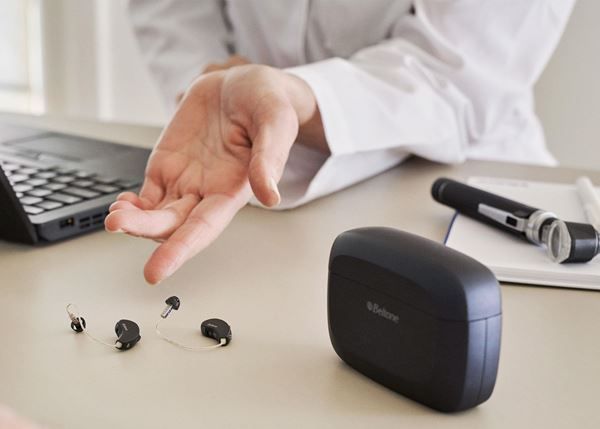
What Type of Hearing Aid is Right For You?
What Type of Hearing Aid is Right For You?
Years ago, people shopping for hearing aids had limited options. But technology has come a long way. Many of today’s hearing aids are so small, they’re virtually undetectable when worn.
How can they be so tiny? Today’s digital hearing aids have microphones that transmit sound to a small computer chip, which adjusts the volume and amplifies the sound frequencies needed to help improve your hearing.
The shell of a custom hearing aid is made from a mold of the user’s ear. Shells come in a variety of shapes, styles and colors to better fit the user’s level of hearing loss, daily routines, and cosmetic preferences.
Six Hearing Aid Shell Styles
Choosing what hearing aid will work for you is a personal decision. What works for one person may not for another, even if both have almost identical audiograms (charts that show the degree of hearing loss for low-, middle-, and high-pitched sounds).
As you work with your hearing care professional trying different styles, it’s important to remember most hearing aids will never completely remove background noise. They are able to vastly improve your hearing. However, due to the way we process sound, they cannot make you hear perfectly again.
There are six main hearing aid shell styles. Each has a different appearance and unique features. You should consider your lifestyle, overall health, and daily routines as you determine which type of right for you.
Completely-in-Canal (CIC)
As you may have guessed a CIC hearing aid is practically invisible, because the shell is entirely hidden within the ear canal. Tiny CIC models leverage the ear’s natural ability to collect sound. By taking impressions, CIC hearing aids are tailored to the dimensions of a patient’s ear canal.
Best for
- Mild to moderate hearing loss
- Users with good manual dexterity
- Users looking for a discreet option
- Users who spends a lot of time outdoors. (These models are less likely to pick up wind noise.)
- Telephone use
Think the CIC might be for you? Learn more.
In-the-Canal (ITC)
ITC styles are worn in the lower portion of the outer ear by the ear canal. Their medium size makes them relatively discreet while offering a secure fit, easy insertion and removal, and a longer battery life.
Best for
- Mild to moderate hearing loss
- Reducing background noise (Larger units include directional microphones.)
- Users with good manual dexterity
- Users looking for a discreet option
- A user who spends a lot of time outdoors. (These models are less likely to pick up wind noise.
- Telephone use
Think the ITC is right for you? Learn more.
Microphone-in-Helix (MIH)
Like the CIC, the main part of an MIH hearing aid is hidden out of sight in your ear canal. This piece is made from an impression taken during your visit. The microphone is separate and is worn within the concha—the curved groove of your external ear— out of sight. A tiny transparent tube transmits sound from the microphone to the component in your ear canal.
Best for
- Moderate hearing loss
- Preserving the natural acoustics provided by the outer part of your ear
- Reducing feedback
- Users with limited dexterity and/or reduced vision
Think the MIH is right for you? Learn more.
In-the-Ear (ITE)
All electronic components are included within the case, which completely fills the bowl of the outer ear. The larger battery can power a bigger receiver, making this style ideal for more profound hearing losses.
Best for
- Profound hearing loss
- Users who want additional features (telecoil, directional microphone, and wireless streaming)
- Users with limited dexterity and/or reduced vision
Think the ITE is right for you? Learn more.
Receiver-in-Ear (RIE)
This type of hearing aid is also called a receiver-in-the-canal (RIC), receiver-in-the-ear (RITE), receiver-in-the-aid (RITA), and canal receiver technology (CRT).
The RIE has a small casing that sits behind the ear, which contains all the electronic components of the hearing aid except for the receiver (also called the speaker). The receiver (or speaker) is inside the ear canal connected to the casing by a narrow, transparent tube.
Best for
- Nearly all types of hearing loss
- Users who hear low frequencies well
- Users looking for a fairly discreet option as well as comfort
- Users with limited dexterity and/or reduced vision
Think the RIE is right for you? Learn more.
Behind-the-Ear (BTE)
About 60 percent of hearing aids sold in the United States are BTE models. A BTE is curved to rest directly behind the ear and connect to the ear canal via a thin transparent tube or a custom-designed ear mold.
Best for
- All types of hearing loss—mild to severe
- Amplifying both low and high frequencies
- Reducing feedback
- Users on a budget
- Users with limited dexterity and/or reduced vision
Think the BTE is right for you? Call us for more information! 757-337-4591
